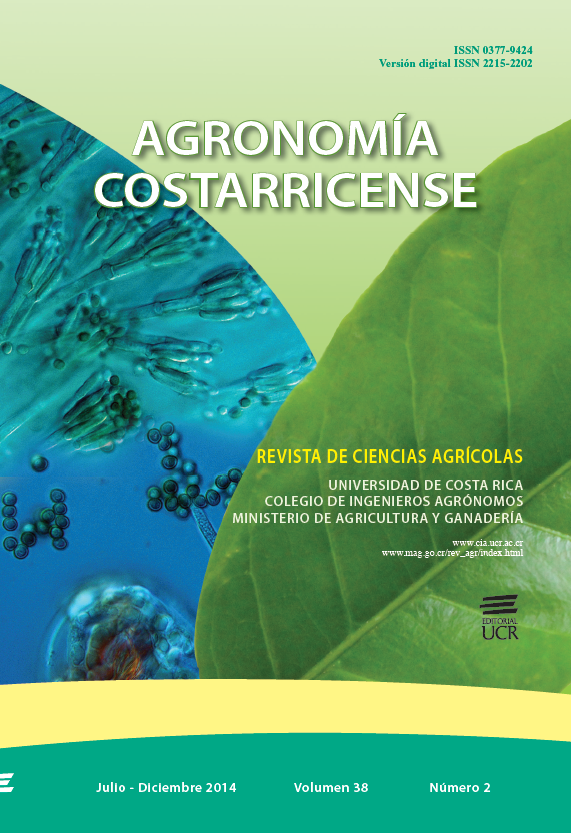Abstract
The aim of this study was to determine the prevalence of hypocalcemia and hypomagnesemia in a Holstein, Jersey and Guernsey cow herd at parturition, under the same feeding, management and environmental conditions. It was conducted in a farm located in Cartago, Costa Rica, and comprised 152 cows (62 Jersey, 41 Guernsey and 49 Holstein). During the close up period the cows grazed kikuyu grass (Kikuyuocloa clandestina) (0.35 Ca, 0.31 Mg and 3.50% K, DM) and were supplemented with 4 kg.animal -1 .d -1 of a concentrate feed low in Ca (0.22 Ca; 0.42 Mg and 1.38% K, DM) plus 1 kg of hay (0.4 Ca; 0.35 Mg and 1.85% K, DM).d -1 . Cows were fed 1 kg of concentrate (0.9 Ca; 0.42 Mg and 1.38% K, DM)/ 2.5 to 3.0 kg of milk during lactation. Blood samples were taken from the coccygeal vessels at peripartum (calving±1d) and analyzed for Ca and Mg. The blood thresholds to classify cows as clinically or sub clinically hypocalcemic were: less than 5.5 and 5.5 to 8.0 mg.dl -1 of Ca, respectively. A value of 1.8 mg.dl -1 of Mg, or lower, was set to classify cows as hypomag- nesemic. Although no significant differences (p≥0.05) were found among breeds for plasma Ca content at parturition, Jersey cows tend to have a lower content of this mineral, specially as parity number increases. Hipomagnesemia prevalence differed (p<0.05) between Jersey and Guernsey breeds. The low prevalence of this metabolic imbalance suggest that the clinical and subclinical hipocalcemia cases observed in this study due to biological aspects proper to Ca homeostasis and are not linked to Ca homeostatic mechanisms in which Mg participates.References
AMARAL D. 2014. Subclinical hypocalcemia, or milk fever, in dairy cows- why all the fuss? Americas Research-based Learning Network. Consultado el 15 de mayo de 2014. Disponible en https://www.extension.org /pages/70227/subcli n ica l-hypocalcemia-or-milk-fever-in-dairy-cows-why-all-the-fuss#.VA86W6NZhtg
Balzarini M.G., Gonzalez L., Tablada M., Casanoves F., Di Rienzo J.A., Robledo C.W. 2008. Manual del Usuario, Editorial Brujas, Córdoba, Argentina. 336 p.
CURTIS C.R., ERB H.N., SNIFFEN G.J., SMITH R.D., POWERS P.A., SMITH M.C., WHITE M.E., HILLMAN R.B., PEARSON E.J. 1983. Association of parturient hypocalcemia with periparturient disorders in Holstein cows. J. Am. Vet. Med. Assos. 183:559-561.
Di Rienzo J.A., Casanoves F., Balzarini M.G., Gonzalez L., Tablada M., Robledo C.W. 2011. InfoStat versión 2011. Grupo InfoStat, FCA, Universidad Nacional de Córdoba, Argentina. Consultado el 10 de junio del 2014 Disponible en http://www.infostat.com.ar
GOFF J.P. 2000. Pathopysiology of calcium and phosphorus disorders. Vet. Clin. North Am. Food Anim. Pract.
:619-639.
GOFF J.P. 2006. Macromineral physiology and application to thefeeding of the dairy cow for prevention of milkfever and other periparturient mineral disorders. Animal Feed Science and Technology 126:237-257.
GOFF J.P. 2008. The monitoring prevention and treatment of milk fever and subclinical hipocalcemia in dairy cows. Vet. J. 176:50-57.
GOFF J.P., HORST R.L. 1993. Oral administration of calcium salts for treatment of hypocalcemia in cattle. J. Dairy Sci. 76:101-108.
GOFF J.P., REINHARDT T.A., BEITZ D.C., HORST R.L. 1995. Breed effects tissue vitamin D receptor concentration in periparturient dairy cows: a milk fever risk factor? J. Dairy Sci. 78 (1):184.
GOFF J.P., SÁNCHEZ J.M., HORST R.L. 2005. Hypocalcemia biological effects and strategies for prevention. Mineral Nutrition Conference.University of Tennessee. USA. 6 p.
HORST R.L. 1986. Regulation of calcium and phosphorus homeostasis in the dairy cow. J. Dairy Sci. 69:604-
HORST R.L., GOFF J.P., REINHARDT T.A. 1990. Advancing age results in reduction of intestinal and bone 1, 25 dyhidroxyvitamin D receptor. Endocrinology 126:1053-1057.
HORST R.L., GOFF J.P., REINHARDT T.A. 1994. Calcium and vitamin D metabolism in the dairy cow. J. Dairy Sci. 77:1936-1951.
LEAN I.J., DeGARRIS P.J., McNEIL D.M., BLOCK E. 2006. Hipocalcemia in dairy cows: Meta-analysis in dietary cation-anion difference theory revisited. J. Dairy Sci. 89:669-684.
LIESEGANG A., SASSI M.L., RISTELI J., EICHER R., WANNER M., RIOND. 1998. Comparison of bone resorption markers during hypocalcemia in dairy cows. J. Dairy Sci. 81:2614-2622.
MARTENS H., KASEBIETER H. 1983. In vitro studies of the effect of sodium and potassium ions on magnesium transport across the isolated rumen mucosa of sheep. Zentralbl Veterinarmed (A) 30:1-14.
NATIONAL RESEARCH COUNCIL 2001. Nutrient Requirements of dairy Cattle. 7 th rev. Ed. National Academy Press. Washington, D. C. 381 p.
REINHARDT T.A., LIPOLIS J.D., McCLUSKEY B.J., GOFF J.P., HORST R.L. 2011. The Veterinary Journal 188:122-124.
ROCHE J.R. 2003. The incidence and control of hipocalcemia in pasture-based systems. Acta Vet. Scand. 97:141-
ROCHE J.R., BERRY D.P. 2006. Periparturient climatic, animal, and management factors influencing the incidence of milk fever in grazing systems. J. Dairy Sci. 89:2775-2783.
SÁNCHEZ J.M. 2008. El pasto kikuyo y su aporte a la nutrición de vacas lecheras, pp. 137-155. In: VI Seminario Internacional. Competitividad en carne y leche. Medellín, Colombia.
SÁNCHEZ J.M., SABORÍO A. 2013 Prevalence of hypocalcemia in grazing Jersey herds in Costa Rica. (Abstract) International Conference in Production Disease in Farm Animals, Uppsala, Sweden, pp. 150.
SZUMILAS M. 2010. Explaining Odds Ratios. J. Can. Acad. Child Adolesc Psychiatry 19(3):227-229.
WILDE D. 2006. Influence of macro and micro minerals in the peri-parturient period on fertility in the dairy cattle. Animal Reproduction Science 96:240-249.
ZETTNER A., SELIGSON D. 1964. Application of atomic absorption spectrophotometry in the determination
of calcium in serum. Atomic Absorption Spectrophotometry 10(2):869-890.


